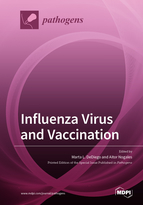Influenza Virus and Vaccination
A special issue of Pathogens (ISSN 2076-0817). This special issue belongs to the section "Vaccines and Therapeutic Developments".
Deadline for manuscript submissions: closed (1 September 2019) | Viewed by 36404
Special Issue Editors
Interests: virology; influenza; coronavirus; innate immunity; virus-host interactions; interferons; inflammation; vaccines; antivirals
Special Issues, Collections and Topics in MDPI journals
Interests: influenza; vaccines; viruses; virus-host interaction; innate immunity
Special Issues, Collections and Topics in MDPI journals
Special Issue Information
Dear Colleagues,
Influenza viruses pose a threat to human health and are responsible for global epidemics every year. In addition to seasonal infections, influenza can cause occasional pandemics of great consequence when novel viruses are introduced into humans. Despite the implementation of comprehensive vaccination programs, influenza viruses continue to pose an important and unpredictable global public health threat, being one of the most significant causes of morbidity and mortality yearly, leading also to a significant economic impact. During the last years, research has been conducted into many alternative approaches to influenza vaccine development, including the generation of universal vaccines. Notably, the significant progress in the field of influenza infection, transmission, and immunity have contributed to our understanding of influenza biology, and to expanding the technological approaches for the generation of more efficient strategies against influenza infections. Moreover, highly remarkable developments have been made in the implementation of new methodologies to evaluate the efficiency of vaccines, and in improved vaccines for domestic animals such as poultry, horses, dogs or pigs that will enable us to decrease the exposure of humans to potentially pandemic viruses. Articles in this Special Issue will address the importance of influenza in human health, and the advances in influenza research leading to the development of better therapeutics and vaccination strategies.
Dr. Aitor Nogales
Dr. Marta L. DeDiego
Guest Editors
Manuscript Submission Information
Manuscripts should be submitted online at www.mdpi.com by registering and logging in to this website. Once you are registered, click here to go to the submission form. Manuscripts can be submitted until the deadline. All submissions that pass pre-check are peer-reviewed. Accepted papers will be published continuously in the journal (as soon as accepted) and will be listed together on the special issue website. Research articles, review articles as well as short communications are invited. For planned papers, a title and short abstract (about 100 words) can be sent to the Editorial Office for announcement on this website.
Submitted manuscripts should not have been published previously, nor be under consideration for publication elsewhere (except conference proceedings papers). All manuscripts are thoroughly refereed through a single-blind peer-review process. A guide for authors and other relevant information for submission of manuscripts is available on the Instructions for Authors page. Pathogens is an international peer-reviewed open access monthly journal published by MDPI.
Please visit the Instructions for Authors page before submitting a manuscript. The Article Processing Charge (APC) for publication in this open access journal is 2700 CHF (Swiss Francs). Submitted papers should be well formatted and use good English. Authors may use MDPI's English editing service prior to publication or during author revisions.
Keywords
- influenza virus
- influenza vaccine
- vaccination
- pandemic
- immune response
- innate immunity
- universal vaccines








